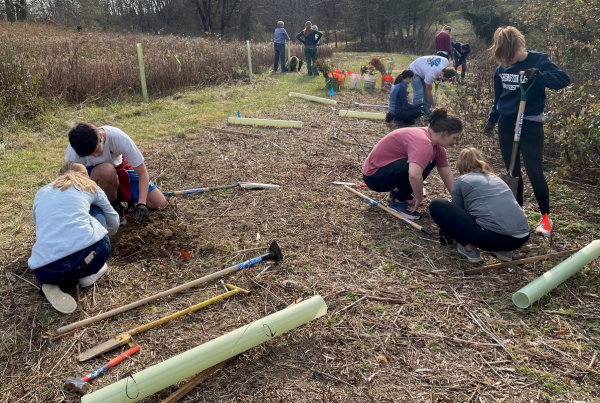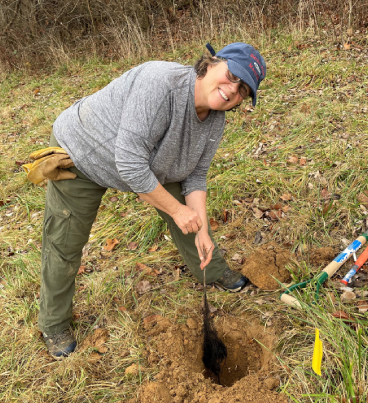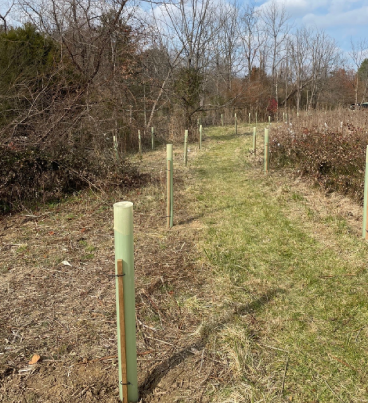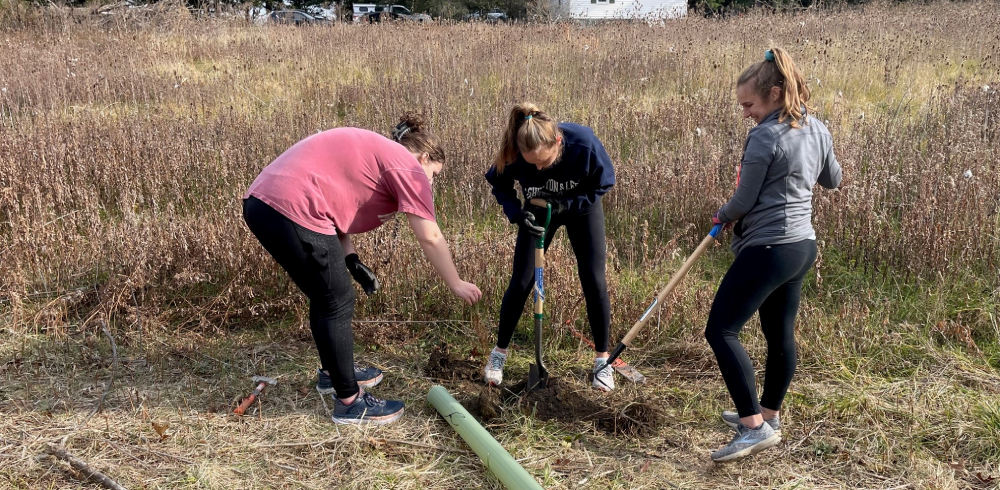This December, the Chesapeake Bay Foundation (CBF), Boxerwood Education Association (a non-profit nature and environmental education center serving the children and families in Rockbridge County), and dedicated volunteers together planted 335 native trees along Moore’s Creek in Lexington, Virginia to create a riparian forested buffer (RFB).

From members of the Virginia Native Plant Society and Master Gardeners to Washington and Lee University (WLU) students and student athletes, almost 30 volunteers planted 250 bareroot tree and shrub seedlings on December 4 to improve our waterways and climate. The remaining 85 seedlings were planted the following Saturday, December 11. The trees and shrubs included the following species: red maple, silver maple, hackberry, gray dogwood, silky dogwood, tulip poplar, swamp white oak, swamp chestnut oak, pin oak, willow oak, white oak, tulip poplar, downy serviceberry, bristly locust, arrowwood viburnum, persimmon, and sourwood.
Improving water quality is often cited as the primary reason for installing RFBs, along with enhancing fish and wildlife habitat, but did you know that they also have enormous potential for carbon sequestration? According to Dybala et al. (2019), riparian forests can sequester more carbon than any other biome, including tropical rainforests! The authors also found that planting a forested buffer as opposed to letting one regenerate naturally can accumulate carbon at a faster rate in the short-term. This is not to say that naturally regenerated buffers aren’t also a great strategy for developing forested buffers along streams, but the intentional planting of trees can more quickly capture CO2 and convert it into stored carbon both in plant materials and soils.

As a James River Buffer Program (JRBP) and COREworks partnership project, the December buffer plantings are a conservation partnership that exemplifies the many reasons for planting RFBs. If you’re wondering, “What’s COREworks?” It is a donation-based carbon offset marketplace based solely in Rockbridge County developed and run by Boxerwood Education Association. According to 2021-2022 COREworks Fellow Ginny Johnson, “COREworks projects create units of offset carbon, and any entity can donate the equivalent amount of money for offsetting that carbon in the COREworks marketplace. All of that money goes into the general pool of the COREworks Fund, which is what funds future projects.” These projects can include one of the following: 1) solar energy production, 2) planting trees, 3) regenerative agriculture practices, or 4) food waste diversion.
Through carbon sequestration and renewable energy production, COREworks projects are designed to reduce atmospheric carbon, which is responsible for the rising temperatures globally. The projects also have a strong focus on community engagement. During the development of the program, Boxerwood worked closely with law and marketing students from WLU, who provided legal knowledge related to solar permitting, market analysis, and so much more, all while building their professional skills. In short, COREworks is all about acting locally to inspire and create worldwide change.
This newly restored RFB will have lasting environmental impacts, such as creating cooler microclimates for people and aquatic and terrestrial life, as well as mitigating the effects of climate change. Equally important are the human connections that were made through the simple act of planting trees. Community members that otherwise might not have met or engaged with one another convened for the common goals of stewarding of local lands and waterways. That locally implemented carbon offset projects have the power to benefit the entire globe exemplifies how truly connected we all are—to each other and to our planet.
To learn more about COREworks, you can email the 2021-22 COREworks Fellow and the head researcher for the program, Ginny Johnson, at ginny@boxerwood.org. To learn more about Boxerwood Education Association and opportunities to get involved, email Boxerwood’s Director of Operations, Karen Stanley, at karen@boxerwood.org, or visit boxerwood.org. To learn more about the Chesapeake Bay Foundation, visit cbf.org. And to learn more about the James River Buffer Program, visit www.jamesriverbuffers.org!


